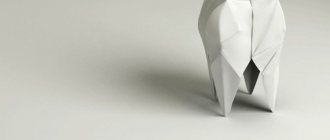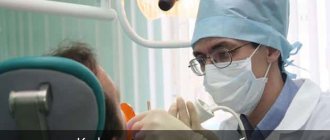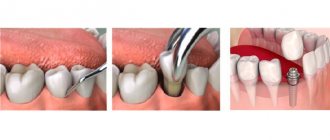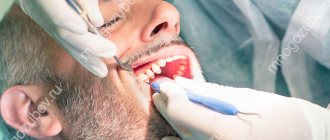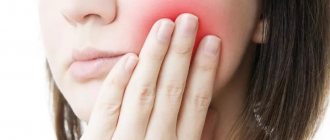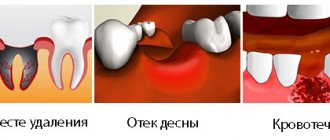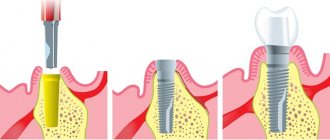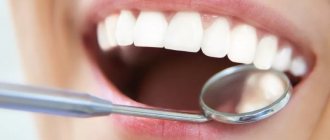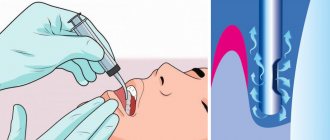Alas, some people in our society are susceptible to a bad habit - smoking. We will not describe the dangers of this habit, and provide evidence of how teeth deteriorate from cigarettes. The article is devoted to a more practical issue - when will it be possible to smoke the first cigarette after tooth extraction surgery.
Tooth extraction at the DaVinci aesthetic dentistry clinic is performed using the most modern instruments and preparations. The patient must be given an anesthetic injection so that he does not feel pain during the operation. But still, tooth extraction is an operation. After it, an open wound will appear in the mouth, the size of which depends on the size of the tooth. Sometimes dentists place drainage and stitches in the gum. The wound will prevent you from eating your usual foods for some time, but if the patient follows all the doctor’s recommendations, then no complications will arise, and soon the hole will stop bothering you.
How smoking affects teeth
Smoking is harmful to the entire body, including the teeth, which are the first to bear the brunt of tobacco smoke and high temperatures. Under the influence of cigarettes, the enamel begins to deteriorate, microcracks appear on it, through which tobacco smoke substances and bacteria present on the teeth quickly penetrate.
Plaque formation in smokers occurs quickly, and it is difficult to remove it on your own. In addition, tobacco lovers are unlikely to brush their teeth after every cigarette they smoke. As a result, the enamel is destroyed, which leads to tooth decay, and the plaque gradually hardens, forming tartar, which contributes to the development of gum disease.
The longer a person smokes, the more their teeth will suffer. Gradually, negative processes will begin to progress, which will undoubtedly entail serious aesthetic and pathological consequences.
Reviews
Below are some reviews. If you have something to say, leave your feedback in the comments below the article, it will be useful to our readers.
I was tormented by my wisdom tooth: it constantly hurt and began to decay. My dentist recommended extraction as the only option.
I immediately agreed: I was tired of constantly taking painkillers. The operation went well, but stitches still had to be placed.
But imagine my surprise when the doctor mentioned quitting smoking! And I am a heavy smoker, a cigarette helps to cope with irritation, anger, even pain.
What it took for me to refrain from taking a puff immediately after leaving the hospital! But willpower took over. The result is that the healing process was successful.
I had a tooth pulled out. The doctor, giving postoperative recommendations, drew my attention to the fact that it is better to abstain from smoking for 2 - 3 hours.
I couldn’t stand it for half an hour - I lit a cigarette: blood began to ooze from the wound almost immediately and did not stop.
I had to seek help from a doctor again. It’s good that I returned to the hospital, because everything could have ended much sadder.
The dentist said that there is a high risk of infection in the wound due to the fact that nicotine corrodes its edges and does not allow it to heal.
Baths made from herbal infusions can alleviate the patient’s condition and speed up the healing process.
A bag of pharmaceutical chamomile is poured with boiling water, infused for half an hour and cooled to room temperature. The infusion should be taken into the mouth and kept for about two minutes without rinsing.
Changes in enamel color in smokers
In the process of smoking a cigarette, smoke enters the human body, which contains tar, nicotine and combustion products. They stick tightly to tooth enamel, staining it an unnatural color. Smokers often have yellow or brown teeth. In this case, localized areas of enamel staining in the form of spots or lines may be observed, indicating the most affected areas.
Features of stains on enamel:
- in the spaces between the teeth - a sign of the formation of tartar, which accumulates a greater amount of coloring substances due to its porous structure;
- along the gum line - a sign of recession, characterized by weakening of the gums, exposure of the neck of the teeth and inflammation of the soft tissues;
- the inner side of the dentition - signals an increased acidic environment as a result of the interaction of saliva and cadmium sulfate (a product of burning a cigarette), the formation of tartar and inflammation of the gums.
Long-term smoking leads to the penetration of dyes deep into the tissue of the dental crown. Not only enamel is negatively affected, but also hard tissues up to dentin. Therefore, the only solution to restore a snow-white smile is professional whitening.
Dentists' recommendations
While there are no particular problems with non-smoking patients, many dental and orthodontic procedures are not available to smokers. Smokers should not undergo surgery to increase jaw bone tissue, apply sutures to soft tissue, or implant implants. During tightening, the seams may come apart and the implant may fall out. But still, if you take precautions and strictly follow the recommendations of dentists, you can achieve results in smokers.
Doctors' advice
- The cotton wool with antiseptic can be removed 20 minutes after tooth resection; if this is not done, bacteria will begin to multiply;
- the blood ball in the tooth socket cannot be spat out or removed in any other way - it protects the wound from the external unfavorable environment and activates tissue regeneration;
- You should rinse your mouth with antiseptics very carefully so as not to accidentally remove the protective ball from the hole;
- It is better to replace the usual rinsing of the mouth with solutions with baths - keep the solution in the mouth and then carefully spit it out;
- if the doctor puts a medicinal substance in the hole, it cannot be removed without permission;
- the first oral hygiene can be performed only the day after resection;
- if the doctor has prescribed a course of antibiotics, it should be completed;
- In case of severe pain, it is recommended to take a painkiller; there is no need to endure discomfort in the gums.
If the removal operation is successful, the first puff can be done after a few hours. Distract yourself from thinking about a cigarette for at least 2 hours.
If the bleeding has not stopped after 2 hours, you can’t think about a cigarette. Tightening may increase bleeding, in which case you will have to seek additional medical help.
What is prohibited
- Clean and rinse the mouth 24 hours after resection;
- steam in a sauna, take a hot bath, sunbathe in a solarium - increasing degrees will increase bleeding from the wound;
- exercise in a fitness club, gym, sports section - until the wound heals and the stitches dissolve;
- when stitches are applied, you can’t not only tighten them, but even smile and open your mouth wide - the stitches will quickly come apart;
- you can have a snack after stress only after 2-3 hours; drinking liquids is also not recommended (or carefully through a straw);
- Alcohol is strictly prohibited - it greatly thins the blood, the wound will begin to bleed;
- You can’t drive a car on this day, it’s better to call a taxi.
For some time you will have to give up the usual spicy, over-salted food, very hot/cold dishes. This means not eating ice cream, drinking cold fruit juice or freshly brewed coffee. Pickled mushrooms and pickled cucumbers are also temporarily prohibited; it is advisable to avoid smoked meats.
You also need to give up rough foods: crackers, hard fruits, vegetables. You should not chew carrots and radishes for several days in a row. Food products should be soft, not over-salted or over-peppered. You will have to stay on a gentle diet for several days until the tissues heal completely.
What do we have to do
- apply ice to the cheek if the pain overcomes - but keep such a compress for no more than ten minutes;
- warm herbal baths - they will soothe damaged tissues, relieve swelling, and eliminate pain;
- take painkillers, anti-inflammatory medications, except aspirin and analgin - they thin the blood.
If you are undergoing medication treatment, you should inform your dentist. He will adjust your medication intake. Some medications affect blood viscosity and cause bleeding, so their use should be discontinued for a while.
Professional whitening
Many smokers resort to home whitening methods. However, even specialized means for lightening tooth enamel are not able to rid tooth enamel of ingrained dye.
Professional whitening, thanks to specially developed technology, helps make tooth enamel lighter by 3, 5 and even 10 shades, depending on the technique used.
The most effective methods are:
- air flow;
- Zoom;
- laser;
- ultraviolet.
As a rule, smokers need several procedures to completely remove the dyes that have become embedded in their teeth. The effect may exceed all expectations.
When can you eat after a light filling?
Today the most popular filling is light. Almost all dentists prefer it. On the first day after the procedure, the filling is extremely sensitive to any influences, since the material has not yet completely hardened. It is better to eat food after 1-2 hours, but it is undesirable to use foods and drinks containing dye, since the filling material easily absorbs coloring pigments.
What foods should be excluded on the first day after treatment:
- coffee, tea, red wine;
- beet;
- dark berries (blueberries, blueberries);
- various sauces.
Food should not be too hot or cold.
What happens if you continue to smoke after teeth whitening?
Gentle methods of teeth whitening for people who have the habit of smoking will not be effective, so dentists recommend using modern hardware techniques, such as Zoom or professional laser cleaning.
After professional whitening, tooth enamel will be somewhat thinned, the protective layer will weaken, and tooth sensitivity may increase. Such consequences are natural, given that the teeth were exposed to external influence. However, after a few days the condition of the tooth enamel will be restored. To strengthen it, you can additionally do fluoridation or remineralization.
After teeth whitening, you can smoke, but you should understand that all the substances of tobacco smoke will instantly penetrate the unprotected tissues of the teeth and cause damage to them, which will be difficult to eliminate. The aesthetic effect will be reduced to nothing. Immediately after bleaching, 2-3 cigarettes will be enough for the enamel to reacquire a pronounced yellow-brown tint.
Many patients believe that hookah can be smoked after teeth whitening, because it is not cigarettes. But this is not true at all. For hookah, tobacco is also used, which also contains chemical components and tobacco leaves. The smoke that is inhaled through the pipe will contain combustion products and the same resins that stain tooth enamel. For this reason, dentists definitely do not recommend hookah after teeth whitening.
Therapeutic measures
After a tooth is removed, an open bleeding wound remains in its place. If a wisdom tooth is removed, a large wound remains in its place. To stop the bleeding, the dentist covers the wound with a cotton swab soaked in a medical solution, which should be removed after 20 minutes. After removing the cotton wool, a small blood clot forms in the hole of the missing tooth, which absolutely cannot be removed. This clot is a guarantee of bone tissue regeneration and promotes rapid healing of a fresh wound.
Do not try to remove a blood clot from the socket: it is necessary for rapid tissue regeneration.
The dentist will treat the hole with a healing composition, and after the removal of wisdom teeth, you are required to take a course of antibiotics. But antibiotics are not prescribed in all cases, but only if a molar with curved or heavily overgrown roots was operated on.
When a large diameter wound surface is formed, sutures may be applied. In this case, the first puff can be done only 2 or 7 days after this procedure. It all depends on the ability of tissues to recover. During the specified period, the sutures will heal, and the doctor will remove the surgical threads.
